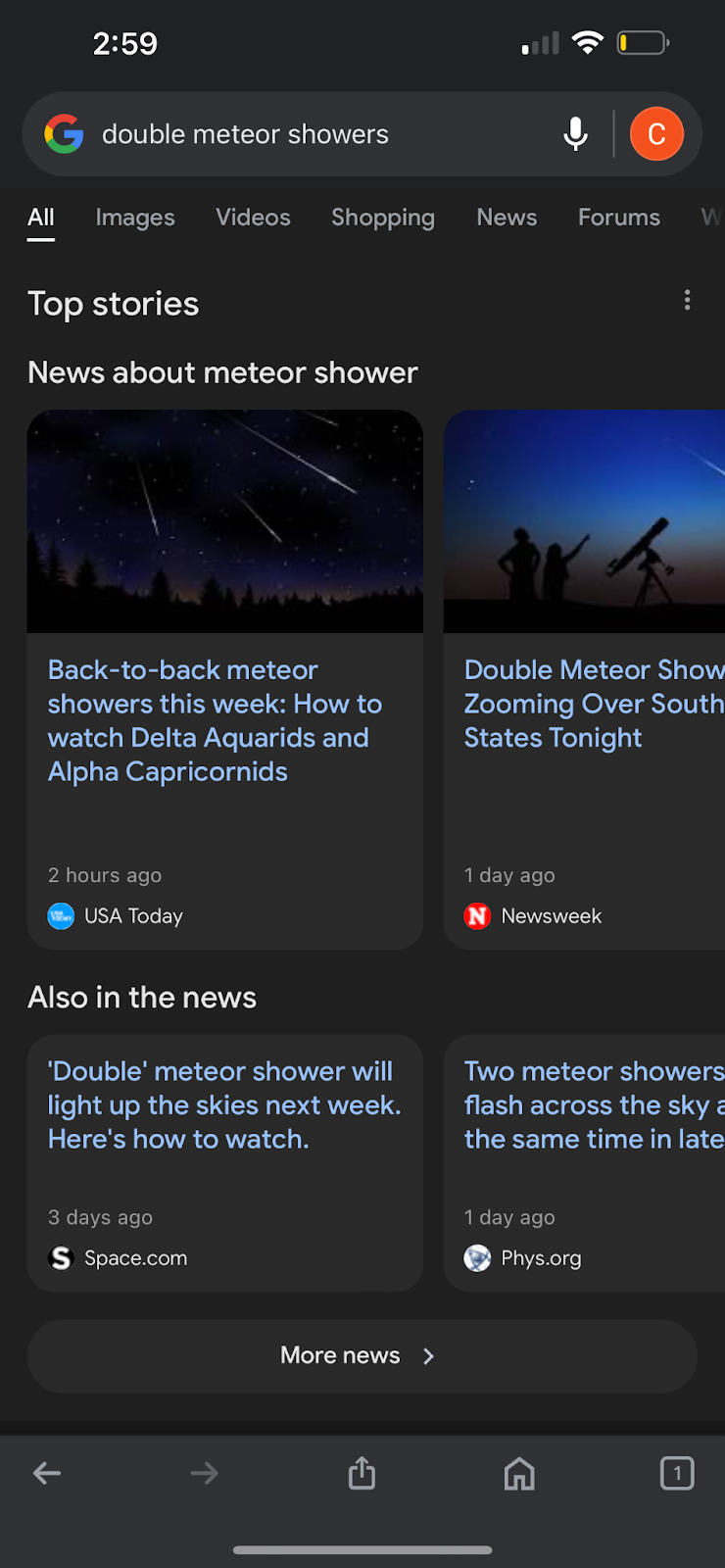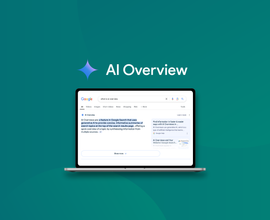Everything You Need to Know to Optimize for Google Discover
Are you looking for another method of driving traffic to your site? Of course, you are. Luckily for you, Google Discover definitely offers an opportunity to bring your content more organic traffic, but that doesn't mean more traffic is a guarantee. You can't count on it. At best, you should think of Discover traffic as bonus traffic. But that doesn't mean you can't optimize your content to appear on Discover.
What is Google Discover?
To understand Google Discover, it helps first to know what it isn’t. It’s not Google Search or Google NewsGoogle News
Google News is a vertical search engine that Alphabet began in 2002. Results from Google searches – mostly news – are listed very prominently as a box in the organic search results in the event of current topicality.
Learn more. While those tools help you find information, Discover does something different. Instead of making you search for content, Discover delivers a personalized feed based on your interests. It’s an effortless way to explore new stories and sources tailored just for you.
Take a look at the visual differences alone between Discover and Google Search.


As you can see, the real estate on Discover is tighter than the traditional. Results in Discover are larger, meaning there's inherently less room for you to appear. Also, the farther down the Discover page you are, the less likely it will be that someone finds your content.
What type of content gets featured in Discover?
Like a traditional Google SERP, the content is largely articles and blog posts. However, other content types, like product pages, images, videos, and web stories , can often be included as well.
Discover is a highly visual feed, with Google themselves recommending : “Include compelling, high-quality images in your content, especially large images that are more likely to generate visits from Discover.” In fact, as short-form video content becomes more popular thanks to platforms like TikTok and Youtube, you’ll likely benefit from focusing on video and web stories as well if your goal is to break into the Discover feed.
How do you access Discover?
For starters, Discover is only available on mobile devices, not desktops. While Google has tested desktop access for Discover, it’s currently not rolled out.
While Discover is accessible on any mobile device—iPhone, iPad, Android—it’s not exactly the same on each device. Mobile users can access Discover through the Google App and Google.com. Some Android devices will also allow users to swipe right from the home screen to access Discover.
What is the benefit for websites that appear in Google Discover?
Google Discover represents an extra source of organic traffic for your website. If you’re able to appear in the Discover feed, that could mean huge boosts in traffic for your business, in some cases, even more traffic than you’ll drive from traditional Google Search. If you’re able to consistently find your way into the Discover feed, you could see huge boosts in your organic traffic and engagement.
Keep in mind that your Google Discover audience might be very different from your usual target audience. So, while your traffic may rise thanks to Discover, that may not directly lead to more conversions.
What type of sites should be leveraging into Google Discover?
Since Google Discover traffic doesn’t always lead directly to improved conversions, appearing within the Discover feed won’t benefit every site the same way, so not every site should focus on it. That said, if you publish a lot of blog content, how-to guides, and other helpful written content, then you might see a traffic boost from Google Discover.
One thing to keep in mind is that content deemed inappropriate by Google will not be included in the Discover feed. In fact, if enough of your content is deemed inappropriate, it could lead to your entire site being ineligible for Discover. So if your content has inappropriate NSFW content, it may lead you to being on the outside of Discover looking in.
How do sites get featured within Google Discover?
As we mentioned earlier, appearing in the Discover feed can be pretty juicy from a traffic perspective. But we also know that you can’t force or request your way onto the Discover feed. Unfortunately, just like with Google Search, no one really knows for sure how Google decides what to include in Discover and where to include it. It’s Google’s secret formula, and they certainly haven’t shared it with me.
So should you just hope for the best that you’ll appear in Google Discover? No. Hope is not a strategy, and you shouldn’t bank on driving traffic through Google Discover. It’s simply too volatile to put your faith into . The most you can do to try and get featured is to create great content that will also perform well on SERPs and enjoy any bonus traffic that Google Discover drives. Follow these best practices to give your content the best chance to succeed in Google Search and the Discover feed.
Best practices to follow to get featured in Google Discover
Like most things with Google, the best practice you can follow to find success is creating high-quality, helpful content. But it would be oversimplifying to say that’s all you can do. Below, we’ll dive into some of the actions you can take to optimize your content for Google Discover.
1. Meet Discover’s requirements
As I mentioned before, you can’t request to appear in Discover. However, your site is, for the most part, eligible to appear if it’s been indexed by Google—as long as it’s not deemed inappropriate content. Some aspects of your content, like images, may violate Google’s requirements for Discover .
Google recommends using large and engaging images in order to be included on Dicosver, but does that mean that your content quality doesn’t matter, and you just need the most compelling imagery and headlines to get on Discover? No. In fact, clickbait and spam content is still subject to Google’s overall spam policies and is likely to lose rankingsRankings
Rankings in SEO refers to a website’s position in the search engine results page.
Learn more and traffic and, in some cases, receive a manual action. Google recommends that your content should not only be helpful, transparent, and engaging.
2. Perform audience research
Since Discover is available through the Google app on any mobile device, you and your team can peruse the tool yourselves, and even create a persona for your target audience. For example, if you’re selling kitchen knives, you can create the persona of a chef by use the interests and follow features in Discover, to get a sense of how the tool would work for one of your customers.
3. Check for manual actions
No, you’re not free from manual actions in Discover. In fact, Google has a specific set of manual action guidelines for Discover . If your content doesn’t conform to Google’s content policies we mentioned earlier, your content will likely receive a manual action and will lose any traffic you were driving through Discover. Just like with Google Search, you’ll need to remove or fix the content in question before you can request that it be reconsidered. You can check if your content has any Discover manual actions in Google Search ConsoleGoogle Search Console
The Google Search Console is a free web analysis tool offered by Google.
Learn more.
4. Nail the headline and image
In Discover, these two aspects of your content are essentially your entire first impression to a user. After all, even if you appear in Discover, it’s no good if nobody clicks on your content. Now, beyond conforming to Google’s image and content policies, your choice of image and headline could help boost your chances in Discover.
Engaging images and headlines do best in Discover, but of course, they do. Who likes unengaging images anyway? But to make the most of the opportunity with images, it pays to audit your website and social content and see what the top traffic drivers have been. From there, see if you can identify any patterns between the featured images that may be pushing clicks. Once you have that foundation, test the boundaries of what you’ve done before, and get creative with the images to try and find the right mix for Discover.
As for headlines, these present an interesting opportunity to work with your image of choice, but also the other headlines for that piece of content. Let me explain. Google doesn’t always use the same page elements in Discover that it does in Google Search. So your article could have one title on Search, but on Discover, it may pull in the open graph or h1 instead. This presents an interesting opportunity to test different headlines and see if you can find new patterns to help you appear on Discover and drive more traffic overall.
How can I track my Google Discover performance?
Traffic from Google Discover can only do you so much good if you can’t track and measure it over time. Compared to traditional search and SEO, tracking and measuring your Google Discover traffic is much more limited. The best way to see how your site performs on Discover is through Google Search Console , though keep in mind that the Discover section will only appear in GSC if your site has appeard in Discover. In addition, GSC will only be able to show you how many users landed on your site through Discover, but it cannot show you how much of that traffic converted.
To track your performance on Discover, simply:
- Login to Google Search Console.
- Open the ‘Performance’ drop-down menu on the left side of the screen.
- Click ‘Discover.’
Unfortunately, there is no dedicated source for Discover traffic within Google Analytics , which makes it difficult to understand if traffic from Discover led directly to a conversionConversion
Conversions are processes in online marketing that lead to a defined conclusion.
Learn more.
Keep an eye on any articles that are driving traffic in Discover. These rankings are volatile and could fall quickly. Check-in on the traffic often to see if there are opportunities to improve the article.
How have Google updates affected Google Discover
Depending on their impact, Google updates can be an SEO’s worst nightmare. Even if Google warns that they’re rolling out an update—which is not always a guarantee—updates can often lead to overnight losses in traffic through search and dramatic rankings drops. So updates can tank a website’s standing on Google Search, but what about Discover? Are your articles, traffic, and rankings in Discover free from the dreaded impact of updates? Unfortunately not. Your traffic from Discover is just as vulnerable to Google updates as it is from traditional search. If your site’s content is low-quality or, for some reason, doesn’t meet the standards of Google’s updates, your content could be “filtered out” of the Discover feed, causing your Discover traffic to plummet.
Once again, the best way to get on Discover is to create helpful content that aligns with E-E-A-T standards, and that’s the best way to remain on the Discover feed too. While some updates may affect your traffic no matter how great your content is, high-quality, helpful content is far more likely than low-quality content to rebound after an initial drop.
FAQ
How do I turn off Google Discover?
Users can turn off Google Discover on iPhone and Android at any time from the Google app. To turn off Discover, simply:
1. Open the Google App
2. Click on your profile and open ‘Settings.’
3. Go to ‘General.’
4. Turn off Google Discover
Google Discover in review
Ultimately, there’s a huge opportunity to drive traffic through Google Discover. Since the Discover feed is curated based on each individual’s specific needs and interests, they may be more inclined to follow a link if they already know it aligns with their interests. That said, Discover traffic is notoriously volatile. Articles can get included in the feed and then fall out of it quickly, causing large fluctuations in engagement in short periods of time. In addition, Discover is also affected by Google updates, just like traditional search, so your traffic is in danger of update-related drops as well. In short, Google Dicsover traffic is a great bonus if you can drive it, but it can’t be counted on as a main traffic driver, so pick your spots to optimize for Discover, don’t bet the farm on it.







